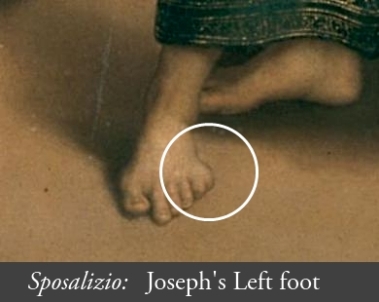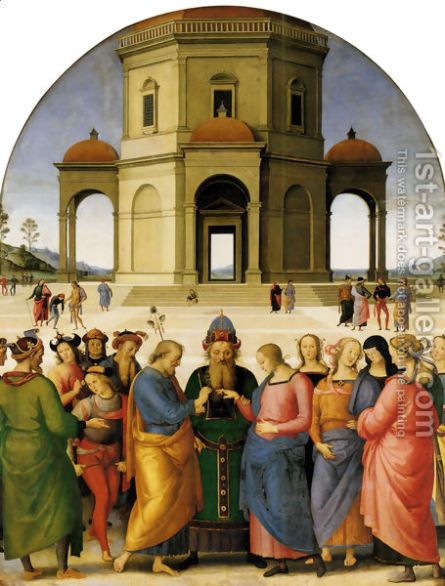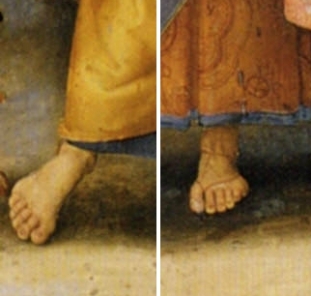 Well this post doesn’t really have anything to do with ugly Renaissance art, but it does touch on less than perfect human body parts in art. That could be politically incorrect which is really not my intention at all, but generally the religious figures depicted look almost unrealistically perfect. Devin has provided us with some truly comical exceptions (I especially like the ugly Renaissance babies tumblr–the cesarean birth of Christ is absolutely on point). This illusion of human perfection is not nearly as intense as it was in the classical period of art, but it is rare to see any kind of physical deformity depicted in art during the Renaissance. There are only three paintings that insinuate that Joseph had a foot deformity on his left foot.
Well this post doesn’t really have anything to do with ugly Renaissance art, but it does touch on less than perfect human body parts in art. That could be politically incorrect which is really not my intention at all, but generally the religious figures depicted look almost unrealistically perfect. Devin has provided us with some truly comical exceptions (I especially like the ugly Renaissance babies tumblr–the cesarean birth of Christ is absolutely on point). This illusion of human perfection is not nearly as intense as it was in the classical period of art, but it is rare to see any kind of physical deformity depicted in art during the Renaissance. There are only three paintings that insinuate that Joseph had a foot deformity on his left foot.
Joseph tends to get lost in the background of many biblical scenes painted prior to and in the early Renaissance days. Especially during the 13th century, and early 14th century, Joseph can be seen as an old dud, often mocked by artists. In the later 14th century and 15th century however, Joseph becomes much more popular and more widely respected by both the church, the public, and by artists. The three paintings where his foot deformity is visible are Francesco di Giorgio Martini’s Nativity, Raphael’s Marriage of the Virgin, and Giulio Romano’s Holy Family. One has to look very closely to see it in all of these paintings, but with a critical eye, it is undeniable that there is something abnormal about Joseph’s left foot. 
Scholars speculate that the deformity is a result of ill treatment of a prior condition; possibly gout. Here is a lovely definition of gout, courtesy of Merriam-Webster dictionary: “a metabolic disease marked by a painful inflammation of the joints, deposits of urates in and around the joints, and usually an excessive amount of uric acid in the blood.” What disease caused his deformity exactly is pretty much irrelevant, but what is important is what his deformity symbolizes. It is believed that Joseph’s form deformity is represented in art as a symbol of his martyrdom.
Contrary to all the beliefs of all the haters out there, Joseph actually played a very crucial role in protecting Jesus and Mary, as well as guiding them to safety on a number of long journeys they took. One example of a journey they took was when they were escaping the wrath of King Harold. On this particular excursion, Joseph lead Mary and Jesus to safety, avoiding a close call. The point is that Joseph acquired this painful looking foot problem because of these numerous long, arduous journeys. According to these three painters Joseph sacrificed a lot in his old age in order to protect the Virgin and Child. He may not have been as outwardly celebrated and recognized as Jesus and Mary, but damn it he did more than drool stupidly in the background!
First of all, this is a detail that I never realize, so I really appreciate this topic has been post here. At least, I learned something new. I am not familiar with Bible or most of the story about Joseph, thus, I’m not sure whether there is any written document or story that had mentioned about Joseph’ s foot deformity. From my opinion, I think this illustration reflect the fact that he is a mortal but carry important mission from God, which can be referred to the protection of Jesus and Mary. Human cannot be perfect, and God wants to show his equality to all human beings. However, with the important mission of protecting Jesus and Mary, Joseph is already different from most of the normal people. Therefore, in order to balance the “power” of Joseph, he got foot deformity. This is my interpretation of his deformity, maybe it is totally wrong, but I believe his foot deformity is another way to show the audience how important he is. As mentioned in the article, Joseph’s figure always appeared in the background that many details, such as the depiction of his foot, may not be included in the painting. I wonder is any other painting ever recorded this phenomena, or these three all the only pieces with this depiction.